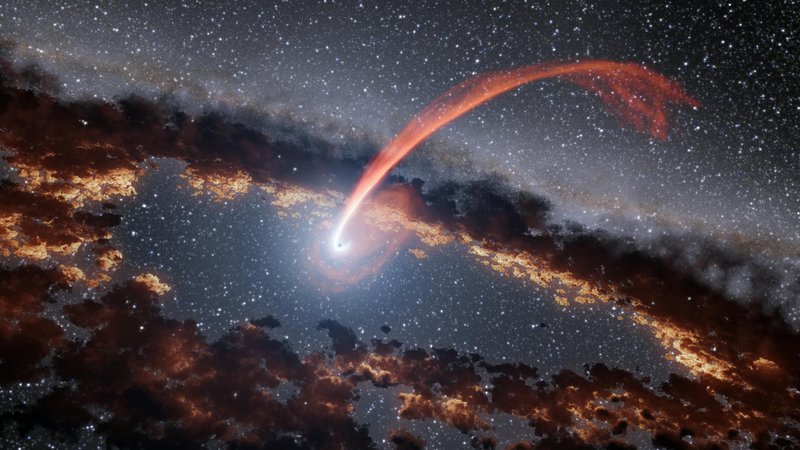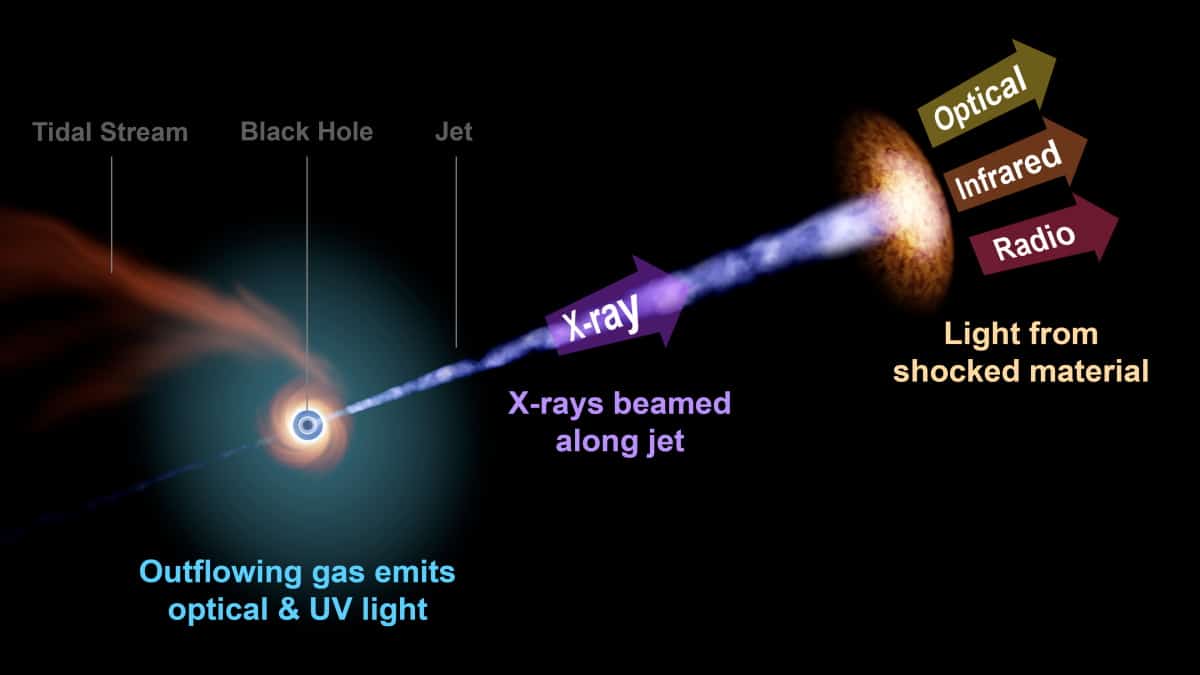Using ESO’s Very Large Telescope (VLT) and New Technology Telescope (NTT), the Las Cumbres Observatory global telescope network, and NASA’s Neil Gehrel Swift Observatory, an international team of astronomers was able to monitor the flare from a tidal disruption event over a six-month period.

Designated AT2019qiz, the event occurred in a spiral galaxy about 215 million light-years from Earth in the constellation of Eridanus and is the closest of its kind yet recorded.
A tidal disruption event is caused when a star passes too close to a black hole and the extreme gravitational pull from the black hole shreds the star into thin streams of material — a process called ‘spaghettification;’ during this process some of the material falls into the black hole, releasing a bright flare of energy which astronomers can detect.

This illustration depicts a star (in the foreground) experiencing spaghettification as it’s sucked in by a supermassive black hole (in the background) during a tidal disruption event. Image credit: M. Kornmesser / ESO.
An unfortunate star at the center of a galaxy can find itself on an orbit that intersects the tidal radius of the supermassive black hole.

This encounter induces a spread in the specific orbital binding energy across the star that is orders of magnitude greater than the mean binding energy, sufficient to tear the star apart in a ‘tidal disruption event.’
A tidal disruption event (TDE) occurs when a star gets too close to a supermassive black hole and gets ripped apart.
This animation shows what would happen if our Sun got too close to a supermassive black hole:
Incredibly powerful event.
— FarLife (@FarLife1) December 27, 2023
The debris of the star is stretched into a long, thin stream, roughly half of which remains bound to the supermassive black hole.
As the bound debris orbits the black hole, relativistic precession causes the stream to self-intersect and dissipate energy.
This destruction can power a very luminous flare, either when the intersecting streams circularize and form an accretion disk, or even earlier if comparable radiation is produced directly from the stream collisions.

“The idea of a black hole ‘sucking in’ a nearby star sounds like science fiction. But this is exactly what happens in a tidal disruption event,” said Dr. Matt Nicholl, an astronomer at the University of Birmingham and the University of Edinburgh.
“But these tidal disruption events, where a star experiences what’s known as spaghettification as it’s sucked in by a black hole, are rare and not always easy to study.”
Dr. Nicholl and colleagues pointed the VLT and NTT telescopes at a new flash of light that occurred last year close to a supermassive black hole, to investigate in detail what happens when a star is devoured by such a monster.

“We found that, when a black hole devours a star, it can launch a powerful blast of material outwards that obstructs our view,” said Dr. Samantha Oates, an astronomer at the University of Birmingham.
“This happens because the energy released as the black hole eats up stellar material propels the star’s debris outwards.”
The discovery was possible because the AT2019qiz event was found just a short time after the star was ripped apart.
“Because we caught it early, we could actually see the curtain of dust and debris being drawn up as the black hole launched a powerful outflow of material with velocities up to 10,000 km/s,” said Dr. Kate Alexander, an astronomer at Northwestern University.
“This unique peek behind the curtain provided the first opportunity to pinpoint the origin of the obscuring material and follow in real time how it engulfs the black hole.”

The team carried out observations of AT2019qiz over a 6-month period as the flare grew in luminosity and then faded away.
The prompt and extensive observations in ultraviolet, optical, X-ray and radio light revealed, for the first time, a direct connection between the material flowing out from the star and the bright flare emitted as it is devoured by the black hole.
“The observations showed that the star had roughly the same mass as our own Sun, and that it lost about half of that to the monster black hole, which is over a million times more massive,” Dr. Nicholl said.
The findings appear in the Monthly Notices of the Royal Astronomical Society.